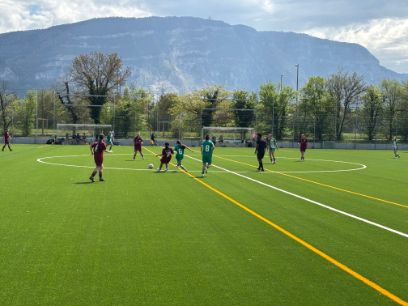- Story
Women’s football: how injuries can be reduced
11.06.2025 In a study involving 250 elite female football players, SFISM researcher Hélène Maystre investigates the links between injury risk and strains on and off the pitch.
Key points at a glance
- Strains in everyday life can have a direct impact on the risk of injury on the pitch.
- The pressures in women’s football are different to those in men’s football.
- One of the reasons for this is that women are often dependent on gainful employment, even if they participate in the WEURO, the women’s EURO.
- A study is investigating which factors on and off the pitch increase the risk of injury for female footballers.
Hélène Maystre is a researcher who plays football – and a keen football player who does research. On 2 July 2025, she will ‘obviously’, as she says, be at the Women’s EURO. “I’m a keen supporter and will be sitting in the first row,” she adds with enthusiasm. After all, “female footballers are heroes”.
Women’s football is different
Hélène Maystre ‘the researcher’ knows only too well what her heroines go through to achieve their best performance in the spotlight of Switzerland’s biggest stadiums. In a large-scale study that measures various factors affecting the health and injuries of professional female players over an entire season, Hélène Maystre wants to examine the correlation between life circumstances off the pitch and performance on the pitch.
Female footballers have to work, study and fulfil social obligations alongside their top level sport.
Of course, there are already studies on this subject. But most of them are dedicated to male footballers. Their results can only be applied to a limited extent, says Maystre, because “women’s football is different”. Some very young players are already playing in the top league. “The context is completely different, as there is no professional women’s league in Switzerland,” explains Hélène Maystre. Almost all the players have to work, study and fulfill social obligations alongside their top level sport,” explains Hélène Maystre. The pressures faced by female players are therefore very different from those of professionals male footballers, who can concentrate fully on their sport. The available resources, training centres and infrastructure also differ significantly.

Strains off the pitch
Preliminary research conducted by Hélène Maystre with 12 to 15-year-old players in Biel indicates that injuries in amateur women’s football frequently occur on a seasonal basis. Injury peaks occur at the beginning or end of intensive phases of play. A number of valuable insights concerning training were derived from this. The fact that at least one of the twenty players examined in the preliminary study was always seriously injured shows that adapted training methods are urgently needed.
The female footballers do this for the young players following in their footsteps. I find this very cool.
In the current study, this approach is applied to professional sport: Maystre’s plan is to interview around 250 players in Switzerland’s U20 W league over the course of an entire season. The participants fill out a weekly questionnaire in which they record their state of health. In addition, physiotherapists document the players’ injuries once a week. The result is a data set of unprecedented size.
Long-term added value for players
“My job is to motivate the players”, says Maystre. It is important, because the added value of the study will be of little use to the participants in the study. Only the next generation of players will benefit from the patterns uncovered and the following adjustments in training and life outside of sport: “The players are not doing this for themselves, but for the young players following in their footsteps. I find this very cool.”
At last someone who’s trying to move things forward!
The study will run until June 2025, with initial results expected around a year later. However, Hélène Maystre is already convinced of the benefits of the study for the players of the future: “Thanks to the large data set, we will be able to show the correlation between social and mental factors (e.g. lack of sleep) and the risk of physical injury”.
Her confidence is shared by the players: “At last someone who’s trying to move things forward!” is a sentence she has heard more than once. Hélène Maystre hopes that some of her current test subjects will make it to the Women’s EURO 2029 with fewer injuries thanks to her research. One thing is certain: she will be there – as a supporter.
